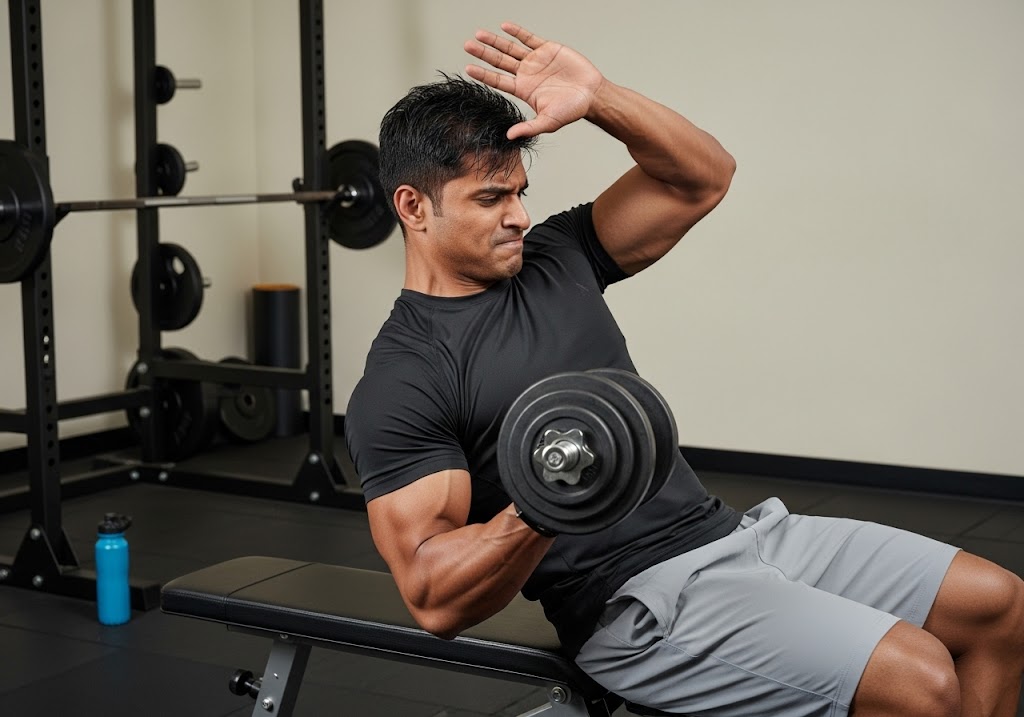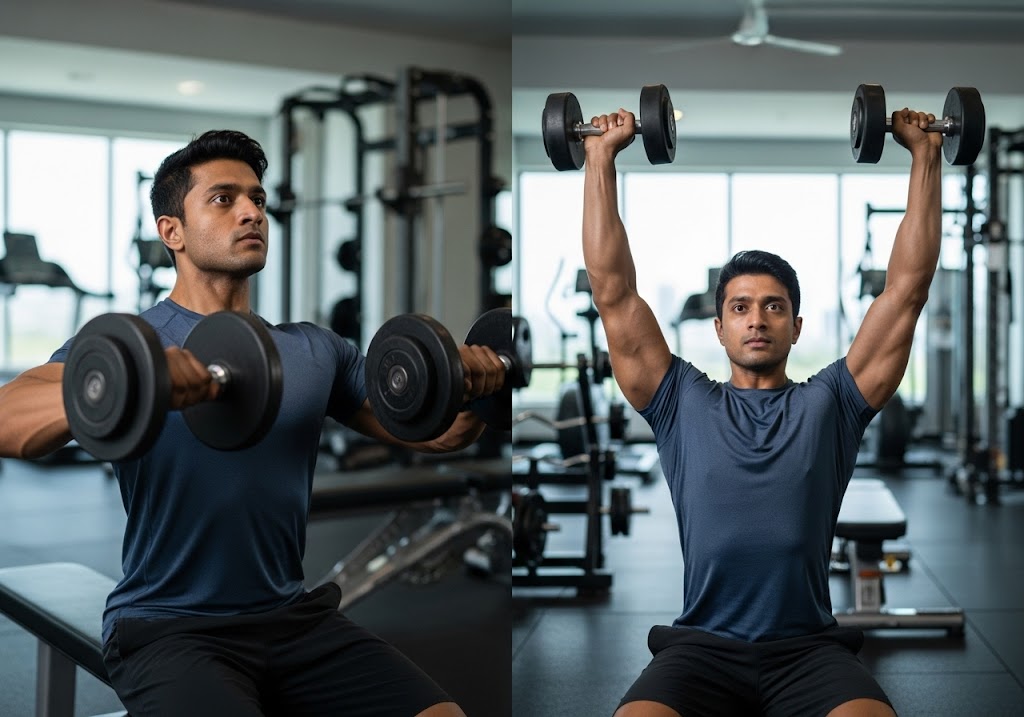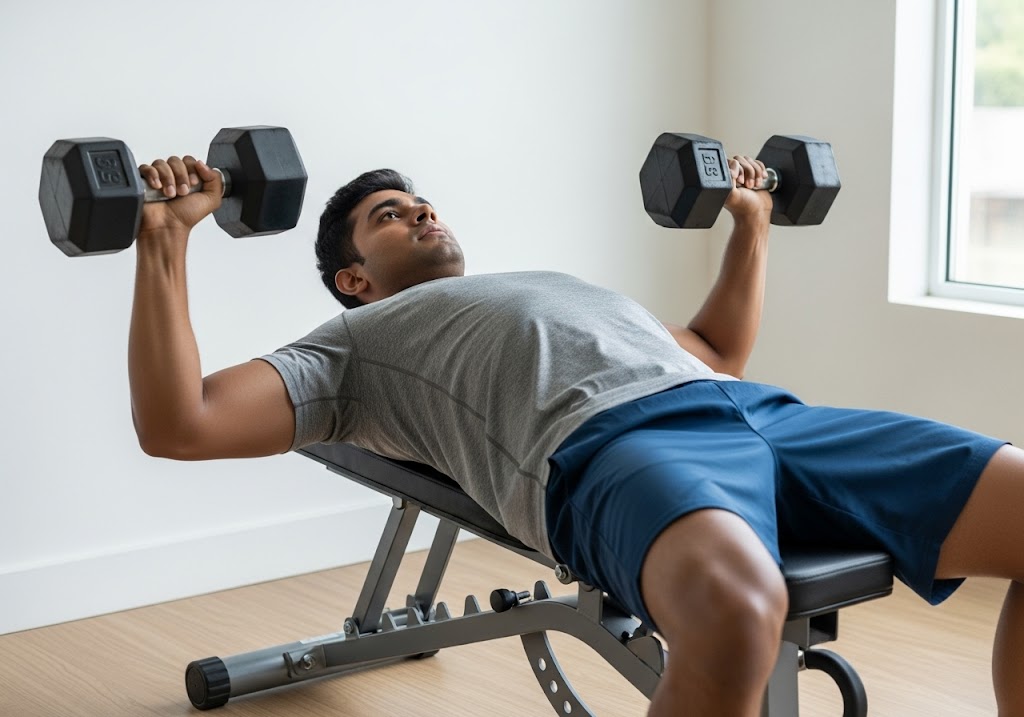Arnold press vs shoulder press differs mainly in wrist rotation and range of motion, with Arnold press targeting all deltoid heads more effectively while shoulder press allows heavier weights for strength building.
Choosing between arnold press vs shoulder press can significantly impact your shoulder development and training results. Both exercises target the deltoid muscles but through different movement patterns and muscle activation levels. The arnold press, popularized by Arnold Schwarzenegger, incorporates a unique rotational movement that engages all three deltoid heads simultaneously. Meanwhile, the traditional shoulder press focuses on vertical pressing strength with heavier loads.
Understanding the key differences between arnold press vs shoulder press helps you select the right exercise for your fitness goals. Whether you’re seeking muscle hypertrophy, functional strength, or injury prevention, each movement offers distinct advantages. This arnold press vs shoulder press comparison examines technique differences, muscle activation patterns, benefits, and practical applications to help you make an informed decision for your shoulder training routine.
Table of Contents
Arnold Press vs Shoulder Press: Key Differences
The fundamental distinction in arnold press vs shoulder press lies in the movement pattern and muscle recruitment. Arnold press begins with dumbbells held in front of your shoulders, palms facing your body, then rotates the wrists 180 degrees while pressing overhead until palms face forward. This rotational component creates a wraparound motion that engages all three deltoid heads more comprehensively than traditional pressing movements.
Shoulder press maintains a fixed wrist position throughout the movement, either with palms facing forward or neutral grip. The weight travels in a straight vertical path from shoulder level to overhead extension. This simplified movement pattern allows for better stability and the ability to handle heavier loads, making it superior for pure strength development and progressive overload applications in arnold press vs shoulder press comparisons.
| Aspect | Arnold Press | Shoulder Press |
|---|---|---|
| Movement Pattern | Rotational with 180° wrist turn | Straight vertical press |
| Range of Motion | Extended, deeper stretch | Standard overhead range |
| Weight Capacity | Lighter loads due to complexity | Heavier weights possible |
| Muscle Activation | All 3 deltoid heads equally | Anterior and lateral focus |
| Coordination Required | High due to rotation | Moderate, straightforward |
| Best For | Hypertrophy and definition | Strength and power |
| Injury Risk | Moderate if performed correctly | Lower with proper form |
| Equipment Options | Dumbbells only | Dumbbells, barbells, machines |
Find out how to start calisthenics as an alternative to weight training.

Benefits of Arnold Press
Arnold press offers unique advantages that make it valuable for shoulder development and overall upper body training. The rotational movement pattern mimics natural shoulder mechanics better than fixed-path exercises, potentially reducing shoulder impingement issues common with traditional pressing movements. When comparing arnold press vs shoulder press benefits, the arnold press stands out for its comprehensive muscle activation.
The exercise provides superior muscle activation across all deltoid regions in arnold press vs shoulder press comparisons:
- Complete Deltoid Engagement – Activates anterior, medial, and posterior deltoid heads simultaneously through the rotational movement
- Enhanced Range of Motion – Allows deeper shoulder flexion at the bottom position, creating greater muscle stretch and activation
- Improved Shoulder Mobility – The rotation promotes better shoulder joint health and flexibility through multiple planes of movement
- Better Muscle Definition – Superior hypertrophy stimulus due to increased time under tension and varied muscle recruitment
- Functional Movement Pattern – Mimics real-world shoulder movements better than straight vertical pressing motions
- Rotator Cuff Strengthening – Engages stabilizing muscles more effectively due to the rotational component
- Reduced Impingement Risk – Natural rotation may decrease shoulder joint compression compared to fixed-path movements
For comprehensive fitness routines, explore how to do jumping jacks as a warm-up exercise.
Benefits of Shoulder Press
Traditional shoulder press excels in building raw pressing strength and allows for systematic progression with heavier loads. The straightforward movement pattern makes it ideal for strength-focused training programs and provides excellent foundation for other overhead movements. In arnold press vs shoulder press strength comparisons, shoulder press typically wins for maximum load capacity.
Shoulder press advantages include superior strength development and training efficiency in arnold press vs shoulder press debates:
- Maximum Load Capacity – Allows 20-30% heavier weights than arnold press due to simplified movement pattern and better stability
- Progressive Overload Friendly – Linear progression through weight increases makes it excellent for systematic strength development
- Athletic Performance Transfer – Movement patterns translate directly to sports requiring overhead pressing power and stability
- Equipment Versatility – Can be performed with barbells, dumbbells, machines, or kettlebells for varied training approaches
- Time Efficiency – Straightforward technique allows focus on moving heavy loads rather than mastering complex movements
- Strength Foundation Building – Provides excellent base for other overhead movements and pressing variations
- Lower Learning Curve – Simple vertical pressing pattern makes it accessible for beginners and efficient for advanced lifters
- Functional Movement Pattern – Mimics real-world activities requiring overhead lifting and carrying motions
Learn about intermittent fasting plan to optimize your training nutrition.
Arnold Press vs Dumbbell Shoulder Press
Understanding arnold press vs dumbbell shoulder press differences helps optimize shoulder training selection. Both exercises use dumbbells but create vastly different muscle activation patterns and training outcomes through distinct movement mechanics and positioning strategies.
| Comparison Factor | Arnold Press | Dumbbell Shoulder Press |
|---|---|---|
| Starting Position | Palms facing body, bicep curl position | Palms forward or neutral grip |
| Wrist Movement | 180° external rotation during press | Fixed wrist position throughout |
| Range of Motion | Extended, deeper shoulder flexion | Standard overhead pressing range |
| Coordination Required | High, rotation timing crucial | Moderate, straightforward pattern |
| Weight Capacity | 70-80% of shoulder press weight | 100% max pressing capacity |
| Muscle Emphasis | All three deltoid heads equally | Anterior and lateral deltoids |
| Time Under Tension | Higher due to rotation component | Standard pressing tempo |
| Shoulder Impingement Risk | Lower due to natural rotation | Moderate with poor form |
| Learning Curve | Steep, requires practice | Moderate, familiar pattern |
| Best Training Phase | Hypertrophy and definition | Strength and power development |
Range of Motion Comparison
The arnold press provides significantly greater range of motion through the rotational component. Starting position allows deeper shoulder flexion, while the rotation engages muscles through multiple planes of movement, creating superior muscle stretch and activation patterns.
For training balance, learn about unilateral vs bilateral training principles.
Loading Capacity Differences
Standard dumbbell shoulder press allows approximately 20-30% heavier loads due to its stability and simplified movement pattern. This makes it superior for strength development and progressive overload, while arnold press excels in muscle building through increased time under tension.

Muscles Worked: Arnold Press vs Shoulder Press
Understanding muscle activation differences between arnold press vs shoulder press helps optimize exercise selection for specific development goals. Both exercises target the deltoid complex but with varying emphasis and activation patterns across the three deltoid heads. Research consistently shows distinct differences when analyzing arnold press vs shoulder press muscle recruitment patterns.
Research shows arnold press activates all three deltoid heads more equally compared to traditional shoulder press variations in arnold press vs shoulder press studies. The rotational movement engages the posterior deltoid significantly more than straight pressing motions, creating more balanced shoulder development. This makes arnold press vs shoulder press selection crucial for complete deltoid development.
| Muscle Group | Arnold Press Activation | Shoulder Press Activation |
|---|---|---|
| Anterior Deltoid | High (Primary) | High (Primary) |
| Medial Deltoid | High | Moderate-High |
| Posterior Deltoid | Moderate-High | Low |
| Triceps | Moderate | High |
| Trapezius | Moderate | Moderate |
| Rotator Cuff | High | Moderate |
| Core Stabilizers | Moderate | Low-Moderate |
The arnold press rotational component recruits stabilizing muscles more intensively, including the rotator cuff complex and deep shoulder stabilizers. This enhanced stability demand contributes to better shoulder joint health and injury prevention compared to fixed-path pressing movements in arnold press vs shoulder press safety comparisons.
For training balance, learn about unilateral vs bilateral training principles.
Advanced practitioners might enjoy how to do a one arm push up for unilateral strength.
Primary Muscle Activation
Both exercises primarily target the anterior deltoid, but arnold press distributes workload more evenly across all deltoid heads. The rotation emphasizes posterior deltoid engagement that’s often neglected in traditional pressing movements, promoting more balanced shoulder development.
Secondary Muscle Engagement
Arnold press engages rotator cuff muscles and deep stabilizers more intensively due to the rotational component. Shoulder press emphasizes triceps activation more heavily, making it better for overall pressing strength development and upper arm muscle building.

Technique and Form Considerations
Mastering proper form in arnold press vs shoulder press requires understanding distinct movement patterns and coordination demands. Each exercise presents unique technical challenges that affect safety, effectiveness, and progression potential for shoulder development.
| Form Element | Arnold Press | Shoulder Press |
|---|---|---|
| Setup Position | Seated preferred for stability | Standing or seated options |
| Grip Starting Point | Neutral, palms facing body | Pronated or neutral grip |
| Wrist Action | Smooth 180° rotation required | Fixed position maintained |
| Elbow Path | Wide arc with rotation | Straight vertical plane |
| Core Engagement | High due to rotational forces | Moderate for stability |
| Breathing Pattern | Exhale during rotation phase | Exhale during pressing phase |
| Common Mistakes | Rushing rotation, incomplete ROM | Excessive back arch, forward head |
| Learning Difficulty | Advanced, requires coordination | Beginner to intermediate |
| Form Breakdown Signs | Jerky rotation, shoulder impingement | Shoulder elevation, wrist bend |
| Progression Focus | Movement quality over weight | Progressive overload emphasis |
Common Form Mistakes
Arnold press common errors include rotating too quickly, using excessive weights, and incomplete range of motion. Many lifters rush the rotation or fail to control the eccentric portion, reducing effectiveness and increasing injury risk. Starting with lighter weights ensures proper movement mastery.
Learn about calories burned in lunges and other compound movements.
Safety Considerations
Both exercises require proper warm-up and progressive loading. Arnold press demands extra attention to shoulder mobility and rotator cuff preparation due to its rotational demands. Shoulder press safety focuses on maintaining neutral spine and avoiding excessive back arch during heavy lifting.
Explore warm up exercises for beginners before starting your shoulder workout.
Weight Selection and Progression
Weight selection strategies differ between arnold press vs shoulder press due to their distinct movement complexities and stability requirements. Arnold press typically requires 20-30% lighter loads than shoulder press variations due to the rotational component and increased coordination demands.
Progressive overload approaches vary between exercises, with shoulder press allowing more traditional linear progression through weight increases. Arnold press progression often emphasizes repetition increases, form refinement, and time under tension rather than purely adding weight.
Starting weights should reflect individual strength levels and movement experience. Begin arnold press with approximately 70% of your shoulder press weight to allow proper form mastery. Focus on control and full range of motion before increasing loads.
| Training Goal | Arnold Press Weight Range | Shoulder Press Weight Range | Rep Range |
|---|---|---|---|
| Muscle Building | 8-15 kg dumbbells | 12-20 kg dumbbells | 8-12 reps |
| Strength | 12-20 kg dumbbells | 18-30 kg dumbbells | 4-6 reps |
| Endurance | 5-10 kg dumbbells | 8-15 kg dumbbells | 12-20 reps |
| Beginner | 3-8 kg dumbbells | 5-12 kg dumbbells | 10-15 reps |
Learn how to lift heavier weights safely and effectively.
Progression Strategies
Arnold press progression focuses on movement quality improvement, range of motion enhancement, and gradual load increases. The complex nature requires mastering the rotational timing before pursuing heavier weights, making it ideal for moderate rep ranges and controlled progression.
Beginner Guidelines
New lifters should master basic shoulder press mechanics before attempting arnold press variations. Start with lighter weights to learn the rotation timing and build shoulder stability before progressing to challenging loads.
Learn how to lift heavier weights safely and effectively.

Programming Arnold Press vs Shoulder Press
Strategic programming decisions for arnold press vs shoulder press depend on training goals, experience level, and recovery capacity. Understanding how each exercise fits into periodized programs maximizes shoulder development while preventing overuse and maintaining progression momentum.
| Programming Factor | Arnold Press | Shoulder Press |
|---|---|---|
| Optimal Rep Range | 8-12 for hypertrophy | 4-8 for strength, 8-15 for size |
| Sets Per Session | 3-4 sets | 3-5 sets |
| Weekly Frequency | 1-2 times per week | 2-3 times per week |
| Training Phase | Hypertrophy and definition blocks | Strength and power phases |
| Session Placement | Mid to end of workout | Early for heavy loads |
| Superset Partner | Lateral raises, rear delt work | Push-ups, dips, tricep work |
| Progression Method | Reps first, then weight | Weight increases primarily |
| Rest Between Sets | 2-3 minutes | 3-5 minutes for heavy sets |
| Periodization Role | Specialization and variation | Foundation movement |
| Recovery Demands | Higher due to complexity | Moderate to high |
Weekly Training Frequency
Both exercises can be performed 1-2 times per week depending on overall program volume and recovery capacity. Arnold press may require longer recovery due to its complexity and muscle activation patterns, while shoulder press can often handle higher frequency training. The arnold press vs shoulder press recovery demands differ significantly due to movement complexity.
Set and Rep Schemes
Arnold press works best with 3-4 sets of 8-12 repetitions for muscle building, while shoulder press accommodates wider rep ranges from 4-6 for strength to 12-15 for endurance. The exercises can be alternated weekly or combined in the same session for comprehensive shoulder development in arnold press vs shoulder press programming.
For cardiovascular health, discover how many steps to burn 500 calories daily.
Injury Prevention and Safety
Injury prevention strategies differ between arnold press vs shoulder press due to their distinct movement patterns and joint stress distributions. Understanding these differences helps minimize risk while maximizing training benefits from both exercises. The arnold press vs shoulder press safety profiles require different preventive approaches.
Arnold press may reduce shoulder impingement risk compared to traditional pressing due to its natural rotation pattern. The movement allows the shoulder joint to move through its natural range without forcing fixed positions that may cause joint compression or impingement. However, arnold press vs shoulder press injury risks vary based on individual anatomy and training experience.
Safety considerations for both exercises include:
- Proper Warm-up – Essential shoulder and rotator cuff preparation through dynamic movements and light resistance
- Progressive Loading – Gradual weight increases allowing tissues to adapt without sudden stress increases
- Form Priority – Maintaining proper technique over lifting heavy weights, especially with arnold press complexity
- Range of Motion Respect – Working within comfortable ranges without forcing extreme positions or painful movements
- Recovery Time – Adequate rest between sessions to allow tissue adaptation and prevent overuse injuries
- Individual Limitations – Recognizing personal mobility restrictions and working within safe ranges
- Professional Guidance – Seeking qualified instruction for proper technique learning and program design
Learn proper technique with how to do dumbbell bench press fundamentals.
Pre-existing Injury Considerations
Individuals with shoulder impingement or rotator cuff issues may find arnold press more comfortable due to its natural rotation pattern. However, both exercises require professional assessment and modification for those with existing shoulder problems or mobility limitations.
Discover what is foam rolling for recovery and injury prevention.
Warning Signs to Stop
Immediate cessation is warranted for sharp pain, numbness, tingling, or significant discomfort during either exercise. These symptoms may indicate improper form, excessive loading, or underlying injury requiring professional evaluation.
Discover what is foam rolling for better recovery and injury prevention.
Which Exercise Should You Choose?
Deciding between arnold press vs shoulder press requires matching exercise characteristics with individual goals, current abilities, and training preferences. Both exercises contribute unique benefits to shoulder development when selected appropriately for specific training phases and objectives.
| Decision Factor | Choose Arnold Press | Choose Shoulder Press |
|---|---|---|
| Primary Goal | Muscle building and definition | Maximum strength development |
| Experience Level | Intermediate to advanced | Beginner to advanced |
| Shoulder Health | History of impingement issues | Good shoulder mobility |
| Training Time | Adequate for form focus | Limited, efficiency priority |
| Equipment Access | Dumbbells only | Multiple options available |
| Strength Imbalances | Addressing deltoid weaknesses | Building overall pressing power |
| Training Phase | Hypertrophy blocks | Strength and power phases |
| Coordination Skills | Good body awareness | Prefers simple movements |
| Injury History | Previous shoulder problems | No significant limitations |
| Long-term Goals | Aesthetic shoulder development | Athletic performance focus |
Compare pressing movements with push ups vs bench press analysis.

Time Efficiency and Workout Integration
Workout time constraints often influence exercise selection in arnold press vs shoulder press decisions. Understanding how each movement fits into training schedules and integrates with other exercises helps optimize shoulder development within available time frames.
| Time Factor | Arnold Press | Shoulder Press |
|---|---|---|
| Learning Time Required | 3-4 weeks to master | 1-2 weeks for basic form |
| Setup Time | Moderate, positioning focus | Quick, straightforward setup |
| Warm-up Requirements | Extended shoulder preparation | Standard pressing warm-up |
| Execution Speed | Slower, controlled rotation | Faster, explosive pressing |
| Rest Periods Needed | 2-3 minutes between sets | 2-5 minutes depending on load |
| Superset Compatibility | Limited due to complexity | High, pairs with many exercises |
| Circuit Training Fit | Poor, requires concentration | Good for circuit integration |
| Cool-down Importance | High, rotator cuff focus | Moderate, standard stretching |
| Session Efficiency | Lower due to technique focus | Higher for strength goals |
| Multi-angle Training | Single exercise covers all angles | Requires additional variations |
Learn about warm up exercises for beginners to prepare properly for shoulder training.
Equipment Requirements and Accessibility
Equipment availability significantly impacts exercise selection when comparing arnold press vs shoulder press options. Understanding equipment needs and alternatives helps maintain consistent training regardless of location or facility limitations. The arnold press vs shoulder press equipment requirements show distinct differences in accessibility and versatility.
| Equipment Aspect | Arnold Press | Shoulder Press |
|---|---|---|
| Minimum Equipment | Pair of dumbbells | Dumbbells, barbell, or machine |
| Weight Range Needed | Light to moderate loads | Light to very heavy options |
| Bench Requirement | Adjustable bench preferred | Optional, can stand |
| Space Requirements | Standard gym space | Minimal space needed |
| Home Gym Suitable | Yes, very practical | Yes, multiple options |
| Commercial Gym Access | All locations have equipment | Universal availability |
| Travel Compatibility | Hotel gyms sufficient | Most locations accommodate |
| Cost Considerations | Basic dumbbell set adequate | More equipment variety beneficial |
| Maintenance Needs | Standard dumbbell care | Varies by equipment type |
| Storage Requirements | Minimal space needed | Depends on equipment choice |
For bodyweight alternatives, check out calisthenics at home no equipment options.
Explore bodybuilding exercises at home for complete workout routines.
For additional calorie-burning exercises, explore how many push ups to burn 100 calories efficiently.
Beginner vs Advanced Training Considerations
Experience level significantly influences success with arnold press vs shoulder press selection. Understanding how each exercise matches different skill levels helps prevent injury while maximizing development potential throughout training progression. The arnold press vs shoulder press learning curves differ dramatically based on movement complexity.
| Experience Factor | Arnold Press | Shoulder Press |
|---|---|---|
| Beginner Suitability | Not recommended initially | Excellent starting exercise |
| Prerequisite Skills | Basic shoulder press mastery | Basic movement patterns |
| Coordination Demands | High, complex movement | Low to moderate |
| Initial Weight Selection | Very conservative approach | Standard progression guidelines |
| Form Learning Curve | Steep, requires patience | Gradual, straightforward |
| Injury Risk for Beginners | Higher without proper instruction | Lower with basic guidance |
| Progression Predictability | Irregular, skill-dependent | Linear, weight-based |
| Strength Foundation Needed | Established pressing base | Can build from scratch |
| Advanced Technique Benefits | High reward for mastery | Moderate skill refinement |
| Long-term Skill Development | Continuous improvement potential | Plateaus eventually |
Understand does calisthenics build muscle for bodyweight training benefits.
Conclusion
The Arnold press vs shoulder press debate highlights how movement variations can significantly impact training outcomes and shoulder development. While both exercises target similar muscle groups, their distinct characteristics serve different purposes in comprehensive fitness programs. Understanding arnold press vs shoulder press differences empowers better exercise selection aligned with individual goals and training preferences for optimal shoulder development results.
Want to master the calisthenics handstand and take your skills to the next level? Whether you’re a beginner or pushing advanced skills, ISC – Indian School of Calisthenics offers expert guidance to help you master bodyweight training. Visit us at SRPF Ground, NH8, Goregaon (E), Mumbai – 400065. For class schedules, personalized coaching, or more details, call +91 77159 53218. Train smart, move better, and unlock your back strength with ISC.
Arnold Press vs Shoulder Press – FAQs
What is the main difference between Arnold press vs shoulder press?
Arnold press involves 180-degree wrist rotation during the movement, while shoulder press maintains fixed wrist position throughout the vertical pressing motion.
Which exercise allows heavier weights in Arnold press vs shoulder press comparison?
Shoulder press allows approximately 20-30% heavier weights due to its simpler movement pattern and better stability compared to Arnold press.
Does Arnold press vs shoulder press target different muscles?
Both target deltoids, but Arnold press engages all three deltoid heads more equally while shoulder press emphasizes anterior and lateral deltoids primarily.
Is Arnold press safer than shoulder press for shoulder impingement?
Arnold press may reduce impingement risk due to its natural rotation pattern, but both exercises can be safe with proper form and appropriate loading.
Can beginners do Arnold press vs shoulder press immediately?
Beginners should master basic shoulder press first, then progress to Arnold press with lighter weights to learn the rotational movement pattern safely.
Which is better for muscle building in Arnold press vs shoulder press?
Arnold press typically provides better muscle building due to increased time under tension, greater range of motion, and more complete muscle activation.
How much lighter should Arnold press weights be compared to shoulder press?
Start with approximately 70% of your shoulder press weight for Arnold press to account for the increased complexity and coordination requirements.
Can you do Arnold press vs shoulder press in the same workout?
Yes, many lifters successfully combine both exercises, often using shoulder press for strength and Arnold press for hypertrophy in the same session.
Which exercise has better carryover to sports performance?
Shoulder press generally provides better strength carryover to athletic movements requiring maximum overhead pressing power and stability.
Should I replace shoulder press with arnold press completely in my training?
Most fitness experts recommend using both exercises strategically rather than completely replacing one, as they serve different purposes in shoulder development.


